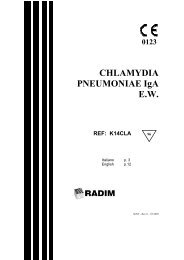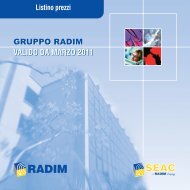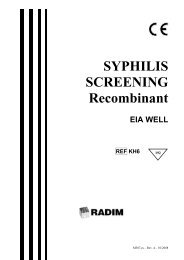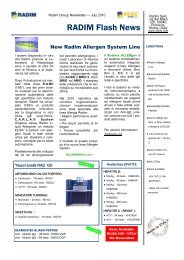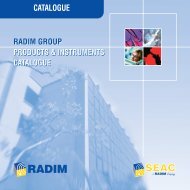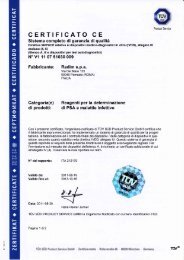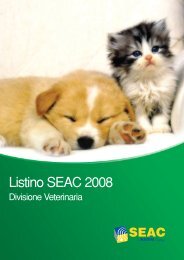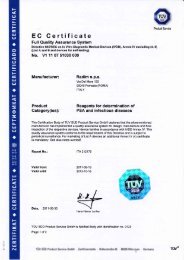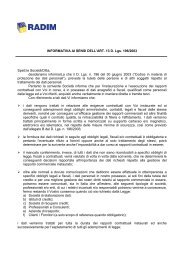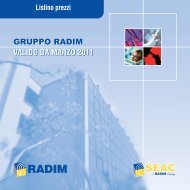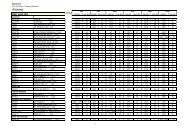APOLIPOPROTEINE A-I (Ref. NPP13), B (Ref. NPP14) - Radim S.p.A.
APOLIPOPROTEINE A-I (Ref. NPP13), B (Ref. NPP14) - Radim S.p.A.
APOLIPOPROTEINE A-I (Ref. NPP13), B (Ref. NPP14) - Radim S.p.A.
You also want an ePaper? Increase the reach of your titles
YUMPU automatically turns print PDFs into web optimized ePapers that Google loves.
<strong>APOLIPOPROTEINE</strong> A-I (<strong>Ref</strong>. <strong>NPP13</strong>), B (<strong>Ref</strong>. <strong>NPP14</strong>)<br />
REAGENTI PER LA DETERMINAZIONE QUANTITATIVA DELLE<br />
<strong>APOLIPOPROTEINE</strong> A-I (Apo A-I) E B (Apo B) NEL SIERO UMANO CON METODO<br />
NEFELOMETRICO<br />
PER USO DIAGNOSTICO IN VITRO<br />
APPLICAZIONI CLINICHE<br />
Le Apolipoproteine sono componenti proteiche che si accompagnano solitamente a una<br />
consistente parte lipidica. Le Apolipoproteine Apo A-I e Apo B sono associate, rispettivamente,<br />
all' HDL (High Density Lipoprotein) ed all' LDL (Low Density Lipoprotein) e presentano funzioni<br />
opposte.<br />
La Apo A-I ha il ruolo di attivare l'enzima (Lecitina-Colesterolo-Aciltransferasi) che esterifica il<br />
colesterolo. Questo, una volta esterificato, può essere trasportato nel fegato ed eliminato.<br />
Concentrazioni ridotte di Apo A-I si associano a rischio di aterosclerosi, anche in presenza di<br />
normale concentrazione di Apo B. In pazienti con lesioni vasali aterosclerotiche, epatite acuta,<br />
cirrosi e nei pazienti trattati con insulina si registrano livelli di Apo A-I molto bassi.<br />
La Apo B, invece, partecipa al trasporto del colesterolo dal fegato alle cellule. Elevate<br />
concentrazioni di questa Lipoproteina concorrono all'aumento di rischio di aterosclerosi e si<br />
verificano in pazienti con alterazioni vasali in atto.<br />
La determinazione quantitativa delle Apolipoproteine Apo A-I ed Apo B risulta più attendibile, ai<br />
fini della valutazione del rischio aterosclerotico, rispetto alla misurazione del solo colesterolo<br />
(HDL ed LDL). Tale rischio viene espresso come rapporto tra Apo B / Apo A-I ed è tanto più<br />
elevato quanto lo è il suo quoziente.<br />
PRINCIPIO DEL METODO<br />
Le Apolipoproteine contenute nel siero umano formano degli immunocomplessi reagendo con<br />
gli anticorpi specifici. Sfruttando il fenomeno della diffrazione della luce che questi<br />
immunocomplessi provocano, si è in grado, per mezzo del nefelometro, di misurare l'intensità<br />
della luce diffratta, che risulta proporzionale alla concentrazione delle Apolipoproteine presenti<br />
nel campione in esame. La valutazione avviene per confronto con un calibratore a<br />
concentrazione nota.<br />
REAGENTI CONTENUTI NELLA CONFEZIONE<br />
− I reagenti devono essere conservati a 2°-8°C. Durante la conservazione, l'antisiero può<br />
presentare flocculazioni o intorbidamenti che non dipendono da contaminazioni e che non<br />
influiscono sull'attività. In questi casi è necessario filtrare l'antisiero prima dell'uso. Allo<br />
scopo, si consiglia di usare filtri monouso con un diametro dei pori di 0.45 5m.<br />
− La data di scadenza di ciascun reagente è indicata sulla rispettiva etichetta e si riferisce al<br />
componente conservato chiuso a 2°-8°C.<br />
• A/S Antisiero: 1 flacone (2 mL) di antisiero policlonale, ottenuto in capra, contro<br />
Apolipoproteina A-1 o B umana altamente purificata. Conservante: NaN3 (
MATERIALE NECESSARIO MA NON FORNITO<br />
L'antisiero deve essere utilizzato con i seguenti reagenti:<br />
• Calibratore Apolipoproteine, (<strong>Ref</strong>. NCPP1APO)<br />
• Controllo Apolipoproteine, (<strong>Ref</strong>. NCPP2APO)<br />
• Diluente, (<strong>Ref</strong>. NDPP1)<br />
• Tampone di reazione, (<strong>Ref</strong>. NDPP2)<br />
• Tampone Supplementare, (<strong>Ref</strong>. NSPP1) (solo per il kit <strong>Ref</strong>. <strong>NPP13</strong>)<br />
• Nefelometro Delta (<strong>Ref</strong>. 010138)<br />
• Altro materiale di consumo e attrezzature sono descritte nel manuale d'uso del Nefelometro<br />
Delta.<br />
AVVERTENZE E PRECAUZIONI<br />
Per ottenere risultati corretti e riproducibili, è necessario osservare le seguenti norme:<br />
− Non usare i reagenti dopo la data di scadenza.<br />
− Evitare accuratamente contaminazioni tra campioni e reagenti; a tal fine è consigliabile<br />
usare pipette con puntali monouso per ogni campione e per ogni reattivo.<br />
Per evitare contaminazioni personali ed ambientali, è necessario osservare le seguenti<br />
norme di sicurezza:<br />
− Utilizzare guanti monouso durante la manipolazione di materiale potenzialmente infetto e<br />
durante il dosaggio.<br />
− Non fumare, mangiare, bere o applicare cosmetici durante l'esecuzione del dosaggio.<br />
− Evitare la produzione di schizzi e la formazione di aerosol; in tal caso, ripulire<br />
accuratamente con ipoclorito di sodio ad una concentrazione del 3%. Il mezzo adoperato per la<br />
pulizia deve essere trattato come residuo potenzialmente infetto ed eliminato secondo le<br />
modalità sotto riportate.<br />
− I reagenti per cui non si fornisce la scheda di sicurezza non contengono sostanze chimiche<br />
pericolose o se presenti, queste sono al di sotto dei limiti di concentrazione definiti nel<br />
D.Lgs.285/98 e nella direttiva CEE 91/155.<br />
− Ai sensi del D.L. italiano n. 22 del 05.02.97, che fa riferimento alle direttive CEE<br />
(91/156/CEE, 91/689/CEE, 94/62/CEE) tutti i rifiuti provenienti da lavorazioni manuali e/o in<br />
automatico sono classificati rifiuti speciali pericolosi con codice di classificazione CER 180103;<br />
devono quindi essere eliminati affidandoli a ditte autorizzate al ritiro ed allo smaltimento.<br />
RACCOLTA E PREPARAZIONE DEI CAMPIONI<br />
Il dosaggio può essere effettuato su campioni di siero umano fresco. I campioni di siero devono<br />
essere completamente coagulati e, dopo essere stati centrifugati, non devono contenere<br />
particelle o tracce di fibrina in sospensione; prima del dosaggio, accertarsi che i campioni siano<br />
perfettamente limpidi. Pertanto, campioni fortemente lipemici o campioni congelati, che dopo lo<br />
scongelamento si presentano torbidi, devono essere chiarificati mediante centrifugazione (10' a<br />
ca.15000 g). Dopo quest'ultima, al di sopra del siero si dispongono i chilomicroni ed i lipidi liberi,<br />
per il test si utilizza la parte chiara. I campioni di siero possono essere conservati a 2°-8°C per 8<br />
giorni, per tempi più lunghi (1 anno) si consiglia di congelarli a -20°C. Evitare ripetuti<br />
congelamenti e scongelamenti.<br />
2
PROCEDIMENTO OPERATIVO<br />
− Tutte le fasi vengono eseguite automaticamente dallo strumento<br />
− Attendere che i reagenti ed i campioni raggiungano la temperatura ambiente (15°-25°C).<br />
− Seguire il procedimento operativo descritto sul manuale d'uso del Nefelometro Delta, che<br />
prevede l'allestimento di quanto segue:<br />
− Curva di calibrazione: viene preparata automaticamente dallo strumento mediante<br />
diluizioni seriali del Calibratore (<strong>Ref</strong>. NCPP1APO) con l'apposito Diluente (<strong>Ref</strong>. NDPP1). Le<br />
diluizioni effettuate vengono quindi impiegate per la calibrazione, che rimane valida purché il<br />
dosaggio dei sieri di controllo rientri nei limiti attesi. La calibrazione deve essere<br />
necessariamente ripetuta ogni qualvolta si utilizzi un nuovo lotto di antisiero.<br />
− Campioni: prima del dosaggio, i sieri vengono diluiti automaticamente dallo strumento alla<br />
diluizione di 1:20 utilizzando l'apposito Diluente (<strong>Ref</strong>. NDPP1). Qualora i valori dei campioni<br />
siano al di fuori dell'ambito di misura è opportuno ripetere il test, utilizzando una diluizione<br />
maggiore o minore.<br />
CONTROLLO DI QUALITÀ INTERNO<br />
Per ogni serie di campioni e ogni volta che si utilizza un nuovo flacone di antisiero, è necessario<br />
effettuare un controllo di accuratezza e di precisione, utilizzando il Controllo per Apolipoproteine<br />
(<strong>Ref</strong>. NCPP2APO). Il controllo viene trattato come i campioni in esame. Per i limiti attesi di tali<br />
controlli fare riferimento alla relativa tabella fornita a corredo della confezione del controllo<br />
stesso.<br />
CALCOLO DEI RISULTATI<br />
La valutazione dei campioni viene eseguita in modo automatico, mediante elaborazione dei<br />
risultati con una funzione logit-log.<br />
VALORI NORMALI<br />
I valori di Apo A-I ed Apo B sotto riportati sono soltanto indicativi. Si raccomanda a ciascun<br />
laboratorio di stabilire i propri intervalli di riferimento :<br />
Proteina siero<br />
Apo A-I donne: 1.25 - 2.15 g/L uomini: 1.10 - 2.05 g/L<br />
Apo B donne: 0.55 - 1.25 g/L uomini: 0.55 - 1.40 g/L<br />
Apo B / Apo A-I donne: 0.30 - 0.90 g/L uomini: 0.35 - 1.00 g/L<br />
CARATTERISTICHE METODOLOGICHE<br />
SPECIFICITA'<br />
Gli Antisieri utilizzati risultano essere specifici per la determinazione delle rispettive<br />
Apolipoproteine umane (Apo A-I, Apo B).<br />
SENSIBILITA'<br />
La sensibilità della determinazione viene definita dal limite inferiore della curva di calibrazione e<br />
dipende quindi dalla concentrazione delle proteine nel calibratore.<br />
Gli ambiti di misura sono riportati nel manuale d'uso del Nefelometro Delta.<br />
3
PRECISIONE<br />
La precisione è stata valutata misurando la variabilità intra-saggio ed inter-saggio.<br />
Intra-saggio Inter-saggio<br />
Proteina n° repl. Valore medio [g/L] CV % n° repl. Valore medio [g/L] CV %<br />
Apo A-I 15 1.60 4.33 15 1.60 2.62<br />
Apo B 15 1.06 3.97 15 1.11 4.10<br />
CORRELAZIONE TRA METODI<br />
Campioni di siero sono stati esaminati con gli antisieri <strong>Radim</strong> anti-Apolipoproteine umane Apo<br />
A-I(y) o Apo B(y). Tali risultati sono stati messi a confronto con un sistema nefelometrico di<br />
riferimento (x). Le correlazioni dei risultati sono riportate nella tabella sottostante:<br />
Proteina Regressione lineare Coeff. di correlazione n° sieri<br />
Apo A-I y = 0.96 x + 0.04 g/L 0.997 125<br />
Apo B y = 0.98 x + 0.26 g/L 0.997 132<br />
LIMITI DEL TEST<br />
La presenza di torbidità o di particelle può interferire nell'esecuzione del test. Si raccomanda,<br />
pertanto, di rimuovere mediante centrifugazione eventuali particelle dovute a sieri non<br />
completamente coagulati, a denaturazione proteica o presenti. Per motivazioni tecniche relative<br />
alla produzione e/o all'invecchiamento dei campioni, i risultati ottenuti con i sieri di controllo e<br />
con i sieri per il controllo di qualità inter-laboratori possono differire in funzione del metodo<br />
utilizzato. Può quindi rendersi necessario valutare i risultati ottenuti facendo riferimento a valori<br />
specifici per i diversi metodi utilizzati.<br />
Si possono verificare interferenze nella determinazione delle Apolipoproteine in presenza di<br />
campioni iperlipemici o con elevata concentrazione di trigliceridi. In questi casi si possono<br />
ridurre tali interferenze eseguendo una maggiore diluizione del campione.<br />
4
APOLIPOPROTEIN A-I (<strong>Ref</strong>. <strong>NPP13</strong>), B (<strong>Ref</strong>. <strong>NPP14</strong>)<br />
REAGENTS FOR QUANTITATIVE DETERMINATION OF HUMAN APOLIPOPROTEIN A-I<br />
(Apo A-I) and B (Apo B) IN HUMAN SERUM WITH NEPHELOMETRIC METHOD<br />
FOR IN VITRO DIAGNOSTIC USE ONLY<br />
CLINICAL APPLICATIONS<br />
Apolipoproteins are the proteic components of lipoproteins. Apolipoprotein A-I is associated to<br />
HDL (High Density Lipoprotein) and Apolipoprotein B to LDL (Low Density Lipoprotein); they<br />
have opposite role.<br />
Apo A-I activates Lecithin-Cholesterolo-Acyltransferase which catalyses the esterification of<br />
cholesterol. The resulting esterified cholesterol can be transported to the liver, metabolized and<br />
excreted. Decreased Apo A-1 level may be a risk factor for atherosclerotic processes, even if<br />
the concentrations of Apo B are normal. Person with atherosclerotic vascular changes, acute<br />
hepatitis, hepatic cirrhosis and insulin-treated diabetics frequently exhibit decreased levels of<br />
Apo A-1. Apo B is involved in transporting cholesterol from the liver to the vessel cell. Elevated<br />
levels of this protein are frequently found in patients with atherosclerotic vascular changes and<br />
are a risk factor for the atherosclerosis.<br />
The assay of Apolipoproteins A-1 and B has a greater prognostic power, in assessing the risk of<br />
atherosclerosis, than the sole determination of HDL and LDL cholesterol. A parameter for<br />
extimating this risk is the quotient Apo B/Apo A-1: the higher the quotient, the greater the risk of<br />
atherosclerosis.<br />
PRINCIPLE OF THE ASSAY<br />
The human serum Apolipoprotein A-1 and B form immune complexes with specific antibodies.<br />
With the light diffraction phenomenon produced by these complexes it is possible to measure<br />
the intensity of scattered light using a nephelometer. This intensity is proportional to the<br />
concentration of the relevant Apolipoprotein A-1 and B in the sample. The result is evaluated by<br />
comparison with a calibrator of known concentration.<br />
REAGENT PROVIDED WITH THE KIT<br />
- Store the reagent at 2°-8 °C. During storage the antiserum can develop precipitates or<br />
turbidity which are not caused by microbial contamination and do not affect their activity. In<br />
such cases the antiserum should be filtered prior to use. Disposable filters with a pore size of<br />
0.45 5m are suitable for this purpose.<br />
- The expiry date is given on the label and it refers to the closed component stored at 2°-8°C.<br />
• A/S Antiserum: 1 vial (2 mL) of polyclonal antiserum, produced by immunisation of goat to<br />
highly purified Apolipoprotein A-1 or B. Preservative: NaN3 (< 0.1 %). Ready for use. After<br />
each use store the reagent, sealed hermetically, at 2°-8°C for 4 weeks. Do not freeze. The<br />
antibody titres (T) indicate the quantity of antigen in mg which will be precipitated in agarose<br />
gel by 1 mL of the corresponding antiserum. The titres are determined by radial<br />
immunodiffusion and are printed on the vial labels.<br />
5
MATERIALS REQUIRED BUT NOT SUPPLIED<br />
The Antiserum must be used with the following reagents:<br />
• Apoliprotein Calibrator, (<strong>Ref</strong>. NCPP1APO)<br />
• Apoliprotein Control, (<strong>Ref</strong>. NCPP2APO)<br />
• Diluent, (<strong>Ref</strong>. NDPP1)<br />
• Reaction Buffer, (<strong>Ref</strong>.NDPP2)<br />
• Supplementary Buffer, (<strong>Ref</strong>. NSPP1) (only for kit <strong>Ref</strong>. <strong>NPP13</strong>)<br />
• Delta Nephelometer (<strong>Ref</strong>. 010138)<br />
• Disposable materials and samples as described in the instruction manual for the Delta<br />
Nephelometer.<br />
WARNINGS AND PRECAUTIONS<br />
In order to obtain correct and reproducible results, the following rules must be observed:<br />
- Do not use reagents beyond their expiry date<br />
- Avoid any contamination among samples and reagents. For this purpose disposable tips<br />
should be used for each sample and reagent.<br />
In order to avoid personal and environmental contamination, the following precautions<br />
must be observed:<br />
- Use disposable gloves while handling any potentially infectious material and while<br />
performing the assay.<br />
- Do not smoke, eat, drink or apply cosmetics during the assay.<br />
- Avoid splashing and aerosol formation; in such cases wash carefully with a 3% sodium<br />
hypochlorite solution. Any such cleaning material must be treated as potentially infectious<br />
and disposed of accordingly.<br />
- The reagents for which a Safety Data Sheet is not supplied do not contain hazardous<br />
chemical substances or, if they do, are below the concentration limits established by the<br />
Italian decree D.Lgs.285/98 in compliance with EEC directive 91/155.<br />
- According to Italian decree D.L. no. 22 dated 05.02.97, in compliance with EEC directives<br />
(91/156/EEC, 91/689/EEC, 94/62/EEC) all waste products originating from either manual<br />
and/or automated processing are classified as hazardous special waste materials (European<br />
classification code180103). As such they must be eliminated by delegating to special<br />
enterprises qualified in waste collection and disposal.<br />
SPECIMEN COLLECTION AND PREPARATION<br />
Fresh serum human samples are suitable for use. Serum samples should have coagulated<br />
completely and, after centrifugation, should contain no particles or traces of fibrin. Prior to use<br />
be sure that samples are perfectly clear. Specimens showing particulate matter or turbidity<br />
should be centrifuged (10 minutes at approx. 15,000 x g) prior to use. Serum samples can be<br />
stored at 2°-8 °C for 8 days, for longer periods (1 year) it is advisable to freeze samples at -20<br />
°C. Repeated Freeze/thawing of samples should be avoided.<br />
6
ASSAY PROCEDURE<br />
- All steps are automatically performed by the instrument.<br />
- Allow the reagents and samples to warm up to room temperature (15° to 25°C).<br />
- Consult the Delta Nephelometer manual for details regarding the operation of the instrument<br />
in preparation of the following:<br />
- <strong>Ref</strong>erence curve: is automatically prepared by instrument with serial dilutions of the<br />
Calibrator (<strong>Ref</strong>. NCPP1APO) using the supplied Diluent (<strong>Ref</strong>. NDPP1). These dilutions are<br />
used for calibration. The calibration is valid as long as control serum performances are<br />
reproduced within their expected limits. Every time a different lot of antiserum is used a new<br />
calibration curve must be prepared.<br />
- Specimens: prior to use, serum samples are automatically diluted 1:20 for Apolipoprotein A-<br />
1 or B assay using the supplied Diluent (<strong>Ref</strong>. NDPP1). If the readings obtained are outside<br />
the assay range the assay can be repeated using a higher or lower dilution of sample.<br />
- Internal Quality Control: for each series of serum samples as well as the initial opening of<br />
an antiserum vial, an accuracy and precision control should be assessed using the<br />
Apolipoprotein Control (<strong>Ref</strong>. NCPP2APO). The controls are assayed and results evaluated<br />
as for patient samples. For the expected values refer to the table provided with the control<br />
kit.<br />
CALCULATION OF RESULTS<br />
The evaluation of samples is automatic and the results are elaborated by means of a logit-log<br />
function.<br />
NORMAL VALUES<br />
The Apolipoprotein A-1 and B values reported below are indicative. We suggest that each<br />
laboratory establish its own normal range:<br />
Protein serum<br />
Apolipoprotein A-I women: 1.25 - 2.15 g/L men: 1.10 - 2.05 g/L<br />
Apolipoprotein B women: 0.55 - 1.25 g/L men: 0.55 - 1.40 g/L<br />
Apo B / Apo A-I women: 0.30 - 0.90 g/L men: 0.35 - 1.00 g/L<br />
ASSAY PERFORMANCE<br />
SPECIFICITY<br />
Antisera used are specific for determination of corresponding human Apolipoprotein A-1 and B.<br />
SENSITIVITY<br />
The sensitivity of the assay is established by the lower limit of the reference curve and depends<br />
therefore upon the concentrations of the proteins in the calibrator.<br />
Typical measuring ranges are given in the Delta Nephelometer instruction manual.<br />
7
PRECISION<br />
Precision was evaluated upon intra- and inter-assay variability.<br />
Intra-assay Inter-assay<br />
Protein repl. n° Mean value [g/L] CV % repl. n° Mean value [g/L] CV %<br />
Apo A-I 15 1.60 4.33 15 1.60 2.62<br />
Apo B 15 1.06 3.97 15 1.11 4.10<br />
METHOD COMPARISON<br />
Serum samples were assayed with <strong>Radim</strong> antisera to human Apolipoprotein A-1(y) and B (y).<br />
These results were confronted with a reference nephelometric system(x). Correlation results<br />
yielded the following data:<br />
Protein Linear Regression Coeff. of correlation n° samples<br />
Apo A-I y = 0.96 x + 0.04 g/L 0.997 125<br />
Apo B y = 0.98 x + 0.26 g/L 0.997 132<br />
LIMITS OF THE ASSAY<br />
Turbidity or particles can interfere with the assay. Any particles formed due to serum samples<br />
not completely coagulated, proteinic denaturation in samples must be removed by<br />
centrifugation.<br />
Due to technical manufacturing reasons and/or aged samples the results obtained for control<br />
samples and inter-laboratory survey samples may differ depending on the assay method used.<br />
It may therefore be necessary to assess these results in relation to method-specific target<br />
values.<br />
8<br />
M303 - Rev. 6 Maggio 2005<br />
− RADIM SpA - Via del Mare, 125 - 00040 Pomezia (Roma) Italia – Tel.: 0039/06/91249.1 -<br />
Fax: 0039/06/91249.443; National Order Entry: 0039/06/91249.702; Export Dept.:<br />
0039/06/91249.701; Customer Care: 0039/06/91249.700; www.radim.it



